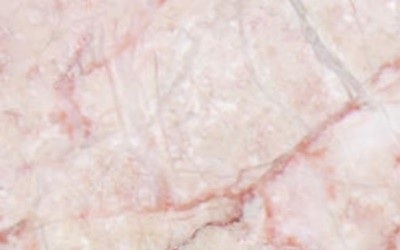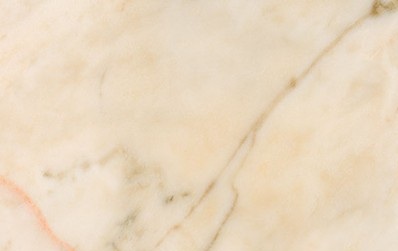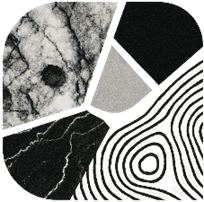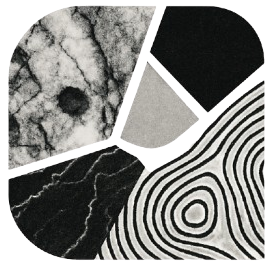The Portuguese region of Alentejo is one of the rare places on Earth where, within a radius of just a few dozen kilometres, an entire spectrum of noble marble tones is born—from icy whites to the subtlest shades of rose. For hundreds of millions of years, nature painted creamy clouds, golden veins and crystalline “sugar” sparkles inside the warm dolomitic layers of the Estremoz Anticline; master stone-cutters then transformed these hidden pictures into architectural icons of great eras.
Today the four-member family of Branco Estremoz, Estremoz Creme, Rosa Aurora and Rosa Portugal showcases the full potential of Portuguese stone. Snow-white Branco Estremoz floods a space with light and ceremony; its warm sibling Estremoz Creme lends domestic cosiness; and the two pink varieties—delicate Rosa Aurora and expressive Rosa Portugal—add a note of refined luxury, making every surface unique. All four share high technical performance, large-format blocks and an uncommon uniformity of pattern, allowing architects to mix different shades of one material and craft seamless, harmonious compositions in both classical palace interiors and sleek minimalist spaces.
Today the four-member family of Branco Estremoz, Estremoz Creme, Rosa Aurora and Rosa Portugal showcases the full potential of Portuguese stone. Snow-white Branco Estremoz floods a space with light and ceremony; its warm sibling Estremoz Creme lends domestic cosiness; and the two pink varieties—delicate Rosa Aurora and expressive Rosa Portugal—add a note of refined luxury, making every surface unique. All four share high technical performance, large-format blocks and an uncommon uniformity of pattern, allowing architects to mix different shades of one material and craft seamless, harmonious compositions in both classical palace interiors and sleek minimalist spaces.
Rosa Aurora
Rosa Aurora is a gentle pink marble with a “brush-stroke” pattern that quarrymen have set aside since ancient times. In the 18th and 19th centuries it served for fireplace mantels and console tops in Portuguese palaces, and today it is especially prized in the Middle East and Asia, where its warm hue and softly “marbled” texture answer the call for understated luxury.
The name translates as “pink dawn”, perfectly describing its appearance. Quarried in the same Marble Triangle as Rosa Portugal, it shows a white or creamy ground delicately tinted with pink, over which drift clouds and bands of pink, peach, grey and golden-brown. A single slab may contain pure cream zones next to vivid pink veins, which is why architects love Rosa Aurora for striking compositional accents.
The name translates as “pink dawn”, perfectly describing its appearance. Quarried in the same Marble Triangle as Rosa Portugal, it shows a white or creamy ground delicately tinted with pink, over which drift clouds and bands of pink, peach, grey and golden-brown. A single slab may contain pure cream zones next to vivid pink veins, which is why architects love Rosa Aurora for striking compositional accents.

Indoors, Rosa Aurora is used chiefly as a statement material: polished large-format panels in bathrooms—combining white and pink slabs with gentle back-lighting—bring a spa-like mood; on floors it is often framed with plain cream marble, turning the natural pattern into a painting; vanity tops or bar counters streaked with pink become focal points, while furniture inlays, fireplace cladding and columns underscore an atmosphere of elegance. Outdoors it suits balconies, colonnades and gazebos, yet its delicate tint is best kept under cover so direct sun does not shift the colour over time.
Rosa Portugal
Rosa Portugal is a signature export of the country: by the mid-20th century its slabs were already cladding hotels, palaces and underground stations worldwide. Each geological layer of the Marble Triangle yields its own shade, so there is no “typical” sample—blocks range from nearly white-pink to rich salmon with creamy clouds. What all varieties share is a soft pink ground, cherished by decorators for its warmth and subtle romance.
The colour runs from tender blush to noble salmon, enlivened by clouds and veins of brown, grey and occasionally green. Such natural artistry makes every slab unique—the architect truly receives an exclusive material that invariably becomes the heart of a composition.
The colour runs from tender blush to noble salmon, enlivened by clouds and veins of brown, grey and occasionally green. Such natural artistry makes every slab unique—the architect truly receives an exclusive material that invariably becomes the heart of a composition.

Inside, Rosa Portugal creates luxurious, “living” surfaces: living-room and hall floors shimmer with individual slab patterns, while wall panels, columns and fireplaces with a polished pink lattice lend romantic ambience. In bathrooms and spas, vanity tops, mosaics and large panels of this marble foster calm relaxation. For furniture—coffee tables, reception desks, bar counters—Rosa Portugal can be polished to a mirror sheen, broadcasting prestige. Exterior uses are also possible: façades, benches or fountains of Portuguese pink marble withstand climate shifts, though in full sun the hue may gently fade, so partial shade or canopies are preferred.
Branco Estremoz
Branco Estremoz—“the white gold of Alentejo”—is quarried in the Estremoz–Borba–Vila Viçosa triangle, within the ancient Estremoz Anticline of Palaeozoic calcitic marbles. Known since Roman times—the blocks appear in the Temple of Diana at Évora and later graced Jerónimos Monastery in Lisbon and El Escorial near Madrid—this marble is still valued for its impeccable whiteness and is exported worldwide.
Aesthetically, Branco Estremoz presents an almost pure snow-white or light-cream field with the faintest grey-beige, sometimes pinkish, threads. Its fine-sugary structure yields an “icy lustre” when polished, and its medium grain and even texture give the stone visual uniformity. Variations are minimal, so architects choose it where noble monochrome and plays of light on a flawless surface are required. In physical terms (compressive strength, frost resistance) Branco Estremoz rivals the best Carrara grades.
Aesthetically, Branco Estremoz presents an almost pure snow-white or light-cream field with the faintest grey-beige, sometimes pinkish, threads. Its fine-sugary structure yields an “icy lustre” when polished, and its medium grain and even texture give the stone visual uniformity. Variations are minimal, so architects choose it where noble monochrome and plays of light on a flawless surface are required. In physical terms (compressive strength, frost resistance) Branco Estremoz rivals the best Carrara grades.

This versatility lets the marble serve in almost any role: vast floors and walls, columns and staircases, fireplace surrounds, worktops and designer sanitary ware. In classical interiors it underscores solemnity; in modern spaces it adds light and visual breadth. Thanks to weather durability, Branco Estremoz suits exterior tasks too—façade panels, balustrades, fountains and smaller architectural forms—where its polished whiteness lends an impression of lightness even to massive structures.
Estremoz Creme
Estremoz Creme is the creamy-beige “brother” of Branco Estremoz, quarried in the same Marble Triangle. Essentially a cream variant of the famed white marble, it displays a light beige ground touched by fine brown or pinkish lines; on some slabs graceful grey-beige streaks and rare reddish threads emerge. Slight pigment differences make the pattern irregular: some blocks nearly monochrome, others traced with expressive “webs”. Warm tone and relatively even texture lend the stone a welcoming feel, desirable in both classic and contemporary schemes. Technically (compressive strength ≈ 102 MPa, water absorption ≈ 0.1 %) Estremoz Creme matches elite European marbles.

Its neutral cream hue excels on floors of living rooms, halls and bedrooms, visually “warming” the space; in bathrooms and spa zones it pairs harmoniously with natural wood and brass or gold fittings. The marble makes superb kitchen and bar countertops thanks to low absorption and good wear resistance, and it performs on stair flights and landings with moderate traffic. On façades, balustrades and columns Estremoz Creme grants an exterior the noble matteness of natural stone; to maintain colour richness in open sun, regular sealing and partial shading are advised.

